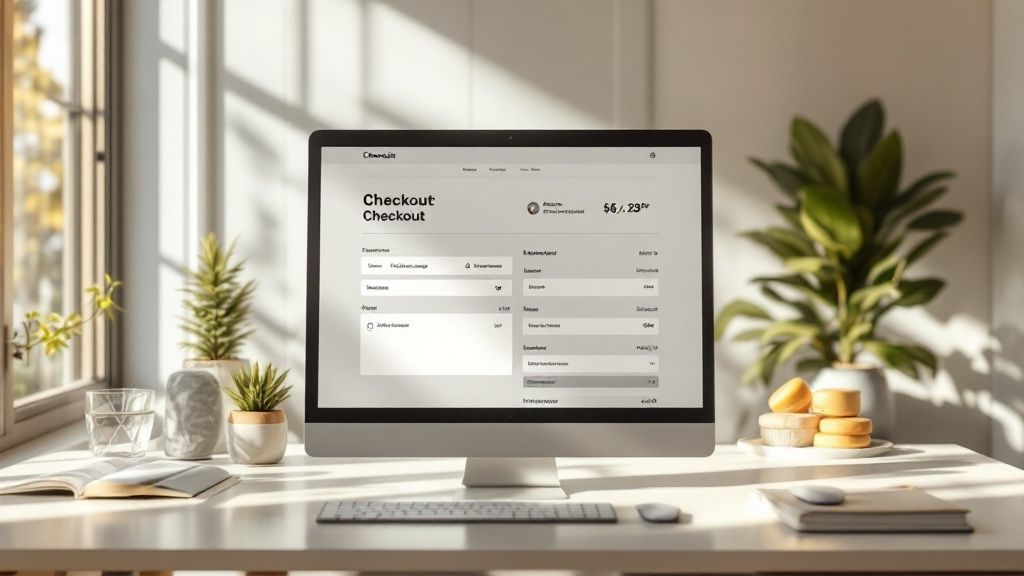How to Reduce Cart Abandonment: Proven Strategies from Top Ecommerce Leaders
February 7, 2025

Understanding Cart Abandonment: Beyond the Surface Statistics

The widely cited 70% cart abandonment rate tells only part of the story. To effectively reduce abandoned carts and boost sales, businesses need to understand what's really driving customers away. This means examining both customer psychology and your store's specific data.
The Psychology of Abandonment
Cart abandonment happens for many reasons. Some shoppers are simply browsing and comparing prices across sites. Others leave because of friction points like unexpected costs or a complex checkout process. Think of your own shopping habits – you might pick up items in a store but abandon them if the checkout line is too long or you spot a better deal elsewhere.
Trust is another major factor in cart abandonment. Just as you'd hesitate to make a purchase in an unfamiliar or sketchy-looking physical store, online shoppers need clear signs that a website is secure and trustworthy. This includes visible security badges, transparent policies, and professional payment processing.
Hidden Costs: A Leading Cause of Abandonment
Extra charges added during checkout are one of the biggest reasons carts get abandoned. According to research, 48% of online shoppers leave their carts when they see unexpected shipping, taxes, or fees at the end. In the US specifically, 47% of consumers abandoned purchases last year because these additional costs were too high. See more data here: Abandoned Cart Statistics. Being upfront about all costs from the start can significantly improve your conversion rates.
Using Data to Drive Improvements
Understanding industry trends is helpful, but you need to analyze your own store's abandonment patterns. Track where exactly customers drop off – is it when shipping costs appear? During payment? At account creation? Finding these specific pain points is like locating a leak – you can't fix what you can't find. Learn more in our guide on expert strategies for reducing cart abandonment.
By identifying the specific reasons customers abandon carts on your site, you can implement targeted solutions rather than generic fixes. This focused approach leads to better results. For more insights, read How to master reducing cart abandonment with expert strategies. Success comes from moving beyond surface-level statistics to truly understand and address your unique abandonment challenges.
Mastering the Mobile Shopping Experience

Mobile shopping has become the primary way people buy online. Yet many businesses still struggle with high cart abandonment on mobile devices. Research shows that 75.5% of shopping carts are abandoned on phones – 5.31% higher than average across all devices. Poor mobile experiences, slow sites, and complex checkouts are key factors driving customers away. See the full data here: Mobile Shopping Cart Abandonment Statistics.
Thumb-Friendly Design and Navigation
Shopping on a small screen shouldn't be frustrating. Thumb-friendly design means making buttons large enough to tap easily and keeping navigation simple and clear. When menus and interactions feel natural, customers are more likely to complete their purchase rather than giving up in frustration.
Optimizing Page Load Speed
Fast loading speeds are essential for keeping mobile shoppers engaged. Even small delays can cause customers to abandon their carts. Making images smaller, cleaning up code, and using browser caching helps create quick, responsive mobile experiences that keep customers moving through checkout.
Streamlined Mobile Checkout
Mobile checkout should be quick and easy. Keep required steps minimal and offer guest checkout so customers don't have to create accounts. Including mobile payment options like Apple Pay or Google Pay lets shoppers complete purchases with just a tap or two.
Mobile-Specific Features and Functionality
Smart mobile features can help recover abandoned carts and boost sales. Push notifications remind customers about items they left behind, while location-based offers draw them back in. Progressive Web Apps (PWAs) provide app-like experiences without downloads, making shopping smoother. When businesses focus on mobile-specific needs, they can create shopping experiences that work better for customers using phones and tablets.
Building Trust Through Transparent Checkout Design

Trust is essential for online stores to succeed. Creating a secure, open, and informative checkout process helps customers feel confident in their purchases and reduces cart abandonment. When shoppers trust your store, they're more likely to complete purchases and become repeat customers.
Displaying Trust Signals Effectively
Visual trust indicators show shoppers your site is secure and legitimate. Adding recognized security badges from Norton or McAfee near checkout fields can quickly boost shopper confidence.
Customer reviews and testimonials also build credibility. Real feedback from past buyers helps new customers feel more comfortable purchasing from your store, especially if they haven't bought from you before.
Clear Communication and Pricing Transparency
Being upfront about all costs is crucial for maintaining trust. 88% of shoppers abandon carts due to hidden fees revealed at checkout. List all shipping costs, taxes, and other charges early in the shopping process, ideally on product pages.
Make product details, return policies, and shipping information easy to find and understand. Offering readily available customer support through phone or chat also creates a more open and trustworthy shopping experience.
Addressing Customer Concerns Proactively
Help shoppers get answers quickly with a detailed FAQ section covering common questions. Provide multiple ways for customers to contact support if they need help during checkout.
Use live chat to assist shoppers in real-time as they complete their purchase. This immediate support prevents frustration that could lead to abandoned carts. Tools like Checkout Links allow you to create personalized checkout links with specific discounts, making it easy to recover abandoned carts through email follow-ups.
Real-World Examples of Trust-Building Elements
Many successful online stores use trust signals effectively. Security badges placed next to payment fields reassure shoppers their data is protected. Progress indicators show customers exactly where they are in checkout and how many steps remain. Applied together, these elements create a smooth, secure checkout process that helps reduce cart abandonment rates.
Implementing Smart Cart Recovery Campaigns

Effective cart recovery campaigns use customer data and personalized messaging across multiple channels to bring back shoppers who abandon their carts. Here's how to create campaigns that drive real results.
Crafting Compelling Recovery Messages
Basic cart abandonment emails don't work anymore. Focus on creating personalized messages that show shoppers exactly what they left behind, along with relevant product suggestions. Make your value clear by highlighting key benefits like free shipping or hassle-free returns.
Split your audience into segments for better results. New visitors might respond well to welcome discounts, while returning customers may want reminders about items they viewed before. Test different approaches with each group to boost recovery rates.
Timing is Everything: Optimizing Follow-Up Sequences
One reminder email isn't enough. Use a strategic sequence to improve your chances of bringing customers back:
- Email 1: Send within 1 hour – friendly reminder showing abandoned items
- Email 2: Send within 24 hours – highlight benefits and include customer reviews
- Email 3: Send within 72 hours – create urgency with time-limited shipping or discount offer
This approach keeps your brand visible without being pushy. Test different timing to see what gets the best response from your customers.
Advanced Targeting Strategies
Use customer behavior data to refine your recovery campaigns. If someone abandons due to shipping costs, follow up with a free shipping offer. When they leave after browsing specific products, suggest similar items they might like.
Go beyond email by using social media retargeting and search ads to reconnect with shoppers after they leave your site. Using multiple channels together can significantly boost your recovery success.
Testing and Optimization
Keep improving your campaigns through regular testing. Try different subject lines, message content, discount offers and timing to find what works best. Track your recovery rates closely and adjust based on real results. Tools like Checkout Links help create personalized checkout options and measure performance, giving you clear data to optimize your recovery strategy.
Optimizing Your Checkout Flow for Maximum Conversions
A complex checkout process often causes shoppers to abandon their carts. This guide examines practical ways to refine your checkout experience and convert more browsers into buyers. Just like a well-designed highway system, your checkout needs to provide a clear, direct path to purchase.
Reducing Friction: A Smooth Path to Purchase
Checkout friction refers to any obstacles that complicate the buying process. Common issues include forced account creation, complex forms, and hidden costs. Research by Baymard Institute found that over 70% of shopping carts are abandoned, with complicated checkouts being a major reason. The solution? Offer guest checkout as the default option – let customers buy quickly without creating an account.
For shoppers who want accounts, make signup simple. Add social login options and passwordless authentication to eliminate the burden of managing yet another password.
Streamlining Form Fields: Less is More
Long forms overwhelm shoppers and drive them away. Think about it – would you complete a lengthy questionnaire just to buy a single item? Focus on collecting only essential information at checkout. You can always gather additional details after the purchase.
Use autofill capabilities to pre-populate fields based on previous entries. Implement smart form validation that provides instant feedback as customers type, allowing them to fix errors right away rather than after submission.
Clear and Transparent Pricing: No Surprises
Hidden costs are a top reason for cart abandonment. Show all fees upfront – including shipping, taxes, and any other charges. Don't wait until the final step to reveal the true total. Building trust means being completely transparent about costs from the start.
Display shipping options and costs on product pages or in the cart preview. Provide multiple shipping choices to accommodate different customer preferences. You might find helpful: How to master fixing Shopify abandoned checkout strategies. With Checkout Links, you can create custom checkout URLs that include pre-applied discounts or free shipping – a great tool for cart recovery campaigns.
Measuring Impact and Driving Continuous Improvement
Reducing cart abandonment requires sustained effort focused on data collection, analysis, and refinement. Successful online retailers know that improvement comes from having strong analytics in place to track key metrics and using those insights strategically.
Key Performance Indicators (KPIs) for Cart Abandonment
To make meaningful progress, you need to track specific metrics beyond just the overall abandonment rate. Important KPIs include:
- Cart Abandonment by Device: Understanding if mobile users abandon more frequently than desktop users highlights where to focus improvements
- Abandonment by Product Category: Higher abandonment for certain products may indicate pricing issues or unclear product details
- Abandonment by Checkout Stage: Seeing exactly where customers drop off helps target fixes like streamlining forms or adding payment options
Setting Up Comprehensive Tracking
Good measurement requires proper analytics setup to capture the full customer journey. Key data points to track include:
- Products Added to Cart: Seeing which items are added but not purchased reveals potential pricing or product page issues
- Checkout Starts: Low checkout initiation suggests cart visibility problems
- Checkout Completions: This final metric completes the picture of your full checkout process
Continuous Testing and Optimization
Data collection is just the start – regular testing drives real improvements. Consider testing:
- Different checkout layouts: A simplified one-page design may boost completions
- Message variations: Updated button text or promotional offers could increase conversions
- Payment method options: More payment choices may help convert more customers
Predictive Analytics and Machine Learning
Leading retailers now use data science to get ahead of cart abandonment. These tools spot patterns to predict which shoppers might abandon, enabling proactive steps like targeted offers or reminders. Think of it as anticipating and preventing issues rather than just reacting to them.
Ready to turn abandoned carts into completed orders? Checkout Links helps Shopify stores recover lost sales through personalized checkout links. Our solution makes it simple to bring customers back and complete their purchases. Visit Checkout Links to learn how we can help grow your business.
 Checkout Links
Checkout Links



